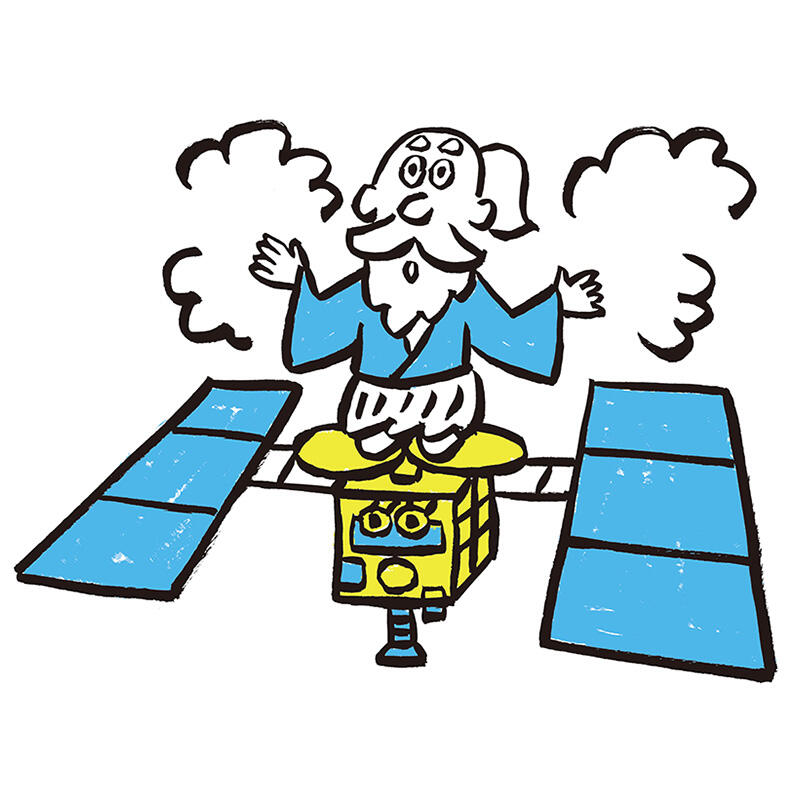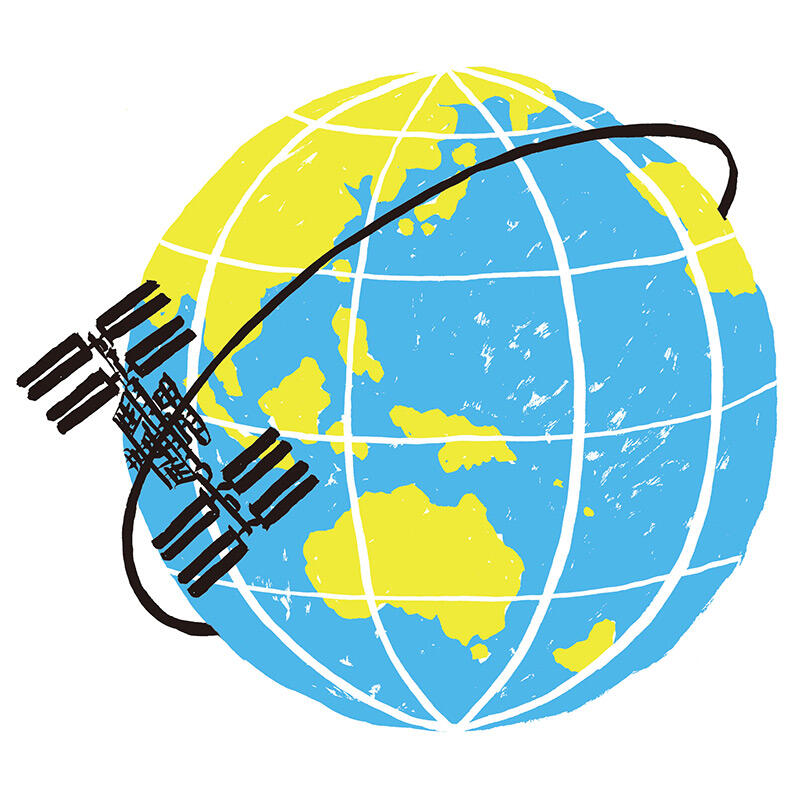Special Feature: JAXA and Time
JAXA and Time
Time began to flow when the universe was born. While "time" is a commonly used term, most generally referring to "a point of time that is flowing continuously," the term also represents a basic scientific notion to recognize events and changes that occur in the world. JAXA embraces inexhaustible scientific challenges related to time of different frames and scales, such as the origin of time, passage of time from past to present to future, and a fraction of a moment.

13.8 billion years
Astronomical observation satellites committed to explaining the history of the universe
The generally accepted theory holds that our universe was born 13.8 billion years ago to enable physical objects to exist in space and time. Immediately after its birth, the universe was composed of only three elements, namely, hydrogen, helium, and a small amount of lithium. Since then, it has been undergoing evolution over 13.8 billion years to become what it is at present. How has this taken place? JAXA's astronomical observation satellite missions are committed to answering this question by explaining the history of the universe.
10-36seconds
Cosmic inflation theory presents a rapid exponential expansion of space
One of the most challenging cosmological question is what occurred before the Big Bang. A widely held model to answer this question is presented by the cosmic inflation theory. In this theory, the early universe underwent an extremely rapid exponential expansion of space from a microscopic size during a fracture of time between 10-36and 10-34seconds after its birth, generating enormous energy that triggered the Big Bang. JAXA's LiteBIRD. project is under consideration to verify this theory. The mission aims to find evidence of cosmic inflation through observing primordial gravitational waves by performing an all-sky CMB (cosmic microwave background) polarization survey.

Infinite time
Objects falling into a black hole appear to take an infinite time to reach it, due to the effect of its strong gravity deforming spacetime
Imagine that you see an object approaching a black hole. Many of you may have a view of the object being absorbed into the black hole in a moment. However, it is impossible to actually witness such a phenomenon. According to the theory of general relativity developed by Albert Einsein, time slows down in the vicinity of a black hole due to effect of its strong gravity. To a distant observer, an object falling into a black hole appears to slow as it approaches the body, taking an infinite time to reach it. Actually, the object has reached the region, though it looks as if it is staying at rest from a distance.

4.6 billion years
"Hayabusa2" committed to elucidating the origin of the Solar System and birth of life
Asteroid Explorer "Hayabusa2" engages in missions to clarify the origin of the Solar System and the birth of life. "Hayabusa2" brought back samples from asteroid Ryugu, whose components are considered to retain organic matter and water from when the Solar System was forming, and we are examining the returned samples to find out the origin and evolution of the Solar System as well as the source of life.

0.4554 seconds
Time dilation observed in "Hayabusa2," where the clock ticked faster than on the Earth
People return from space travel and realize that time has passed several times faster on the Earth than on the spacecraft while they were flying on it―a familiar subject of science fiction works. This is based on the effect of "time dilation," which in the theory of special relativity describes the phenomenon where in a system moving relatively fast, time elapses more slowly than in a stationary system. Also, the theory of general relativistic gravitational time dilation has been established to explain the phenomenon where time elapses faster in an outer space system than one on a planet under gravitational effect. The passage of time recorded in "Hayabusa2" during its six years of space travel was examined in light of the two relativity theories, finding that the clock on "Hayabusa2" ticked faster by 0.4554 seconds than that on the Earth.
Up to 40-odd minutes
Communication time lags between "Hayabusa2" and the ground control
Radio waves, medium for communication between spacecraft and the ground control, travel at about 300,000 kilometers per second, the same speed of light. You may think it is very fast, but it is not necessarily so given the vastness of cosmic space. During travel, Asteroid Explorer "Hayabusa2" was as far away as up to 350 million kilometers from the Earth, a distance for a radio wave to take about 20 minutes to travel. Assuming that you send an order to "Hayabusa2" at this position from the ground control at 12:00 to take photography of asteroid Ryugu, the order will arrive at the destination after 20 minutes, at 12:20, then, you will receive the photography sent back in immediate response to the order, after another 20 minutes at 12:40. This means that the back-and-forth communication with "Hayabusa2" involves a total of up to 40 minutes of time lag.
380,000 years
Murky skies of the universe cleared up
The early universe immediately after the Big Bang was filled with free traveling elementary particles, which did not bind together under high-temperature high-density "fireball" conditions. In this state, photons (light) could not propagate freely because of prevailing electrons standing in the way, resulting in a cloudy, opaque cosmos. About 380,000 years later, however, a change occurred in this situation. As the universe was expanding and cooling down, electrons and protons began to attract each other to bind together, thus reducing the number of free electrons. This brought about a clear, transparent cosmos allowing free propagation of photons. Photons enabled to travel freely in this process can be observed in the present cosmic microwave background (CMB) radiation, a source of information on the earliest state of the universe.
About two days
Impact of solar storms reaches the Earth
Storm-like phenomena are observed to take place in the universe. A solar storm is one type of such phenomena. It is a disturbance on the Sun, most notably caused by solar flares, a large explosion on the solar surface. This often triggers a solar particle event where charged particles are emitted by the Sun to the surrounding space, which may reach the vicinity of the Earth, depending on the location and size of the flare, and affect radio communication. It takes two days on average for emitted particles to reach the Earth. Solar Physics Satellite "HINODE", JAXA-led solar observation project, aims to clarify mechanisms of explosive events occurring on the Sun and predict impact such event may have on the Earth.
7 years
"BepiColombo" to enter Mercury's orbit
Mercury Exploration Mission "BepiColombo" is an international cooperation project between Japan and Europe for Mercury exploration. Mercury has been elusive from scientific research in the past, making it dubbed as a "mysterious planet," while some of its basic characteristics are known, including the body being one of the Solar System's two planets that have magnetic fields, with the remaining being the Earth. The BepiColombo mission plans to perform a comprehensive study on the near-Earth planet by observing its magnetic fields, atmosphere, surface and interior, with a view to illuminating the origin and evolution of terrestrial planets. The mission will deploy two observation probes, which are designed to repeatedly perform swing-by maneuvers, a gravity-assisted orbit and velocity control technique, in order to reduce fuel consumption, before entering the orbit of Mercury in December 2025, seven years after the launch.
200 million years
The Sun orbits around the center of the Milky Way
Imagine that the Earth and other planets in the Solar System are orbiting around the Sun. The view you have in mind may be showing the Earth turning around the stationary Sun. In fact, however, the Sun also orbits around the center of the Milky Way galaxy, at the rate of approximately 220 kilometers per second, taking about 200 million years to make a full circle. The star has completed 23 orbits over the past 4.6 billion years since its birth.
12 billion years
The lifetime of the Sun ends when hydrogen runs out
The Sun generates a vast amount of energy from nuclear fusion of hydrogen in its core, the source of bright radiation. The Sun will continue to burn the internal hydrogen for 12 billion years since its birth until the "fuel" runs out about 7 billion years from now. After this, the star will shed its outer layers and become a stellar core remnant known as a white dwarf, slowly cooling down and gradually stopping shining. It is interesting that stars with larger amounts of fuel (hydrogen) have a shorter lifespan.

Approximately 90 minutes
ISS goes full circle around the Earth at a blistering speed
The International Space Station (ISS) is a habitable station that accommodates a number of astronauts engaging in various experiment and research activities. It orbits the Earth at an altitude of 400 kilometers at the rate of approximately 7.7 kilometers per second, requiring only 90 minutes to make a full circle. This condition brings to the facility a cycle of daytime (when it is lit by the Sun) and nighttime (when the Earth blocks light from the Sun) of 45 minutes each.
9 hours
What's time in the ISS? ―Time lag with the Tsukuba Space Center
When traveling abroad, you will probably set your clock forward
or backward according to the local time. This practice is
essential when traveling in space. The ISS adopts the Coordinate
Universal Time (UTC), the official world standard time, which is
nine hours behind the Japan Standard Time (JST). Therefore,
participants in morning tour sessions around the Tsukuba Space Center find the main control
room scarcely staffed by flight controllers (during
nighttime hours on the ISS).
347 days 8 hours 33 minutes
All-time record for the total number of days spent in space by a Japanese astronaut
Astronaut WAKATA Koichi holds an all-time record for the total duration time spent in space by a single Japanese astronaut. He has made four space flights in the past, spending in space a combined total of 347 days 8 hours 33 minutes, a period of nearly one year. In his last long-duration mission on the ISS in 2014, he served as commander, becoming the first-ever Japanese astronaut to undertake the role. His next, and fifth space flight is scheduled for the fall of 2022 or later, when he will break his own record.
28 hours 17 minutes
All-time record for the total number of hours spent by a Japanese astronaut engaging in EVA
Astronaut HOSHIDE Akihiko holds an all-time high for the total duration time spent by a single Japanese engaging in extravehicular activity (EVA). In September 2021, he carried out his fourth EVA mission, primarily to replace power switchboards of the ISS. With the mission completed, the combined total hours he spent engaging in EVA reached 28 hours 17 minutes, a record high set by a single Japanese astronaut.
One year
Future astronaut candidates selected for the new era
In 2021, JAXA started to recruit new astronaut candidates for the first time in 13 years. JAXA eased qualification requirements for this recruitment, in order to seek applications from a wider areas regardless of academic specialization, with a view to developing capacity for future lunar missions. Closing the application, the agency has started the screening process scheduled for a period of one year. Applicants passing documentary examinations are subject to a five-step selection process, which includes document screening, STEM tests, interviews, and aptitude tests, over months from May 2022 to February 2023. Then, shortlisted astronaut candidates will receive basic training for the following two years in order to become certified astronauts.
84.69 years
Space experiments expected to enable longer human health span
According to the Ministry of Health, Labour and Welfare, Japan's average life expectancy as of 2020 was 81.64 years for men, 87.74 years for women, and 84.69 years for the combined total. These numbers are a result of the continued growth of the Japanese life expectancy supported by progress in medicine, improvement in the nutritional status, and other factors. That said, much remains to be explained about aging mechanisms. In 2020, JAXA conducted a joint mouse habitat mission in the ISS, which suggested that long-term space travel can accelerate the aging process of astronauts, due to the effect of spaceflight stressors, such as microgravity. The experiment also suggested the existence of genes capable of curbing the acceleration of aging. These findings from on-orbit experiments are expected to help humans live a longer and healthier life.

2 hours
"DAICHI-2" (ALOS-2) delivers disaster monitoring data to the ground
The Advanced Land Observing Satellite-2 "DAICHI-2" (ALOS-2) demonstrates its strengths particularly in the event of natural disasters, such as earthquake and volcanic activities. ALOS-2 observes damage situations and crustal movements by sending radio waves to the ground and receiving reflected waves. Observation data can be delivered to the ground control in two hours at fastest, at any time of night or day and regardless of weather conditions. The satellite plays a significant role in protecting human life in the event of disaster, where the first 72 hours after the occurrence are the most critical to ensure survival.
2 days
"SHIKISAI" (GCOM-C) updates global observation data
Global Change Observation Mission-Climate "SHIKISAI" (GCOM-C) is equipped with a sensor capable of recognizing a total of 19 different types of visible and invisible light, including ultraviolet and infrared rays. The sensor monitors atmospheric aerosol distributions, appearance and temperature of land and ocean surfaces, soil moisture content, among other global conditions, for various purposes, such as understanding the climate change situation, planning disaster control measures, enhancing fishery, agriculture, and other industrial activities. Moving in a low-Earth orbit at an altitude of 800 kilometers, GCOM-C updates overall observations basically about once every two days, demonstrating its capabilities for high-frequency monitoring and high-resolution imaging.
13 years
"IBUKI" (GOSAT) has continued engaging in greenhouse gases observation
The Greenhouse gases Observing SATellite "IBUKI" (GOSAT) was launched in 2009 to monitor the global distribution of carbon dioxide (CO2) and other greenhouse gas (GHG) concentrations from space, aiming to contribute to control of global warming. In those days, when there was no universal standard for measuring GHGs, "IBUKI" became the world's first satellite mission to introduce a universal tool for that purpose. This mission is in its 13th year and still in operation, becoming the world's longest-ever satellite to engage in observations based on the same original standards. Monitoring data over the past years indicate GHG concentrations increasing year by year.
Less than 1 second every 300,000 years
Accuracy of clock in GPS satellite
The global positioning system (GPS) is an integral part of our life. One of the most popular uses is a smartphone app to provide precise location information at any time or any place. This function is supported by an atomic clock mounted on a GPS satellite. A radio wave travels at about 300,000 kilometers per second. This means, for example, a time lag of one microsecond (1/1,000,000 second) results in 300 meters of range error. Therefore, the accuracy of clock is essential to functional GPS. The errors of clocks on board the Quasi-Zenith Satellite "MICHIBIKI" are designed to be less than one second in 300,000 years.
24 hours
Geostationary satellite comes full circle around the Earth
There are various types of artificial satellites, including the geostationary satellite, which flies in orbit at an altitude of about 36,000 kilometers above the Earth's Equator. An object in such an orbit has an orbital period equal to the Earth's rotational period, 24 hours, so to ground observers, it appears motionless. This is a reason for the term "stationary satellite."

270 seconds
Automatic countdown sequence for rocket launch
We imagine many of you had the experience of watching a live rocket launch countdown event, hearing the numbers called down to zero and feeling a sense of tension. For the launch of H-IIA, Japan's current mainstay launch vehicle, and H3 under development, a 270-second automatic countdown sequence is applied to carry out a series of automatically controlled last-minute procedures, including torch ignition and main engine start. The countdown is initiated by the responsible commander pressing the relevant button, to set off the full automation process. The only possible procedure to be performed manually during the 270-second sequence is to press the emergency stop button.
30 minutes
Critical period of time from liftoff to satellite separation
The launched rocket climbs high into the sky with a roar. It feels like the launch event climaxes at this moment, which is wrong, however. The truth is, the rocket's major duties to complete the mission come after launch, specifically transporting satellites to outer space and inserting them into the target orbit. In common projects for insertion into heliosynchronous orbits or geostationary transfer orbits, successful satellite separation should be confirmed within around 30 minutes after liftoff. This is a critical duration of time to determine whether or not the years-long rocket project proves successful.
3 hours
Epsilon shortens time duration from the last access to mounted satellites up to liftoff
Satellite missions generally wish to secure as long a time as possible before launch to perform last-minutes duties, such as for adjustment and inspection. In order to meet such wishes, the Epsilon Launch Vehicle is equipped with automatic physical inspection systems to allow access to mounted satellites up to three hours before launch countdown, offering the world's highest-level convenience.

Critical 11 minutes
Critical period of time prone to aviation accidents
Have you ever heard of the term "critical eleven," an airline industry jargon? According to accident statistics, 70% of aviation accidents occur during the three minutes after takeoff and eight minutes before landing, known as "critical eleven" minutes, a period of time in an airflight that is very prone to accidents. Aiming to increase safety related to the critical eleven issue, JAXA's Aviation Technology Directorate engages in research and development to invent and improve technologies for prediction of and protection against specific weather events related to turbulences, thunders, and clouds as well as for detection and prevention of human errors.
Illustration:SANDER STUDIO TEXT:Shiori Shimizu
All the images are copyrighted ©JAXA unless otherwise noticed.